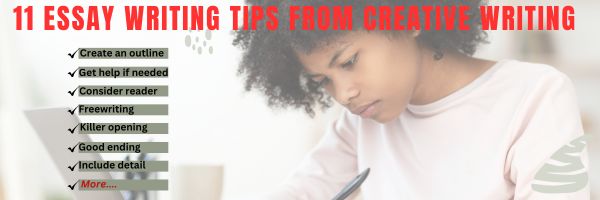Creative writing techniques can make essays more engaging and original while maintaining the required objective structure. A member of the Ask a Tech Teacher team, when preparing an essay example for her class on the impacts of social media on mental health, used freewriting to brainstorm ideas and created a vivid opening scene describing a teenager’s day (she teaches High School), highlighting moments of social media interaction and their emotional effects. This approach not only captured students’ attention but structured arguments more clearly.
Check out these key strategies to improve essay writing, pulled from the creative genres:
Improve Your Essays Using Creative Writing Techniques
If you feel like all ideas avoid you and you can’t come up with an engaging writing style for your essay, rest assured you aren’t alone. Students all over the world struggle with writer’s block, low inspiration levels, and so on. However, it’s possible to use creative writing ideas to help you come up with a unique essay.
Creative writing focuses on originality and encourages you to use your imagination to express ideas uniquely. However, essays are more objective, as they require facts and evidence to support your claims. Still, you can use a smart combination of both, and this article explains how.
Top Writing Techniques For Better Essays
First things first, creative writing, as the term self-explains, is about producing original fiction. In simple words, it’s all about writing for entertainment or fun. However, it doesn’t mean that you can’t use techniques for creative writing to improve your essays.
We’ve prepared a few valuable tips that you can use to improve your essay. Some of these ideas may fit your writing style and help create high-quality essays and impress your teachers.
Create An Outline Or Plan
It’s a must to have a plan when you’re writing anything — unless it’s a grocery store list, although even then, you must consider what you should buy. Begin by organizing your initial thoughts and ideas because this approach helps you organize your ideas clearly and guarantees you cover all necessary points.
Start with the main topic or thesis, and write it down at the top. Then, list the key points you want to discuss in your writing. Arrange these points in a logical order. Make sure each point connects smoothly with the next. This way, your writing will be clear and understandable. Include examples or facts for each key point.
A clear outline saves time and helps you stay focused as you don’t go off-topic. This method will make your points stronger and provide clarity to your readers.
Look for help when needed
It is fine to seek a logical answer to the question, “Who or what can write essay for me?’, and the answer can be an AI generator. You may need inspiration and guidance from AI, which has a vast database on your topic and training to write in an academic style. Such assistance shouldn’t be considered cheating since you are just looking for support.
Use generated paper to learn and improve your writing skills, and forget about the countless hours spent rewriting several drafts.
Think About The Audience
Always consider who will read your work and think about their interests, needs, and expectations. This approach helps you tailor your content to engage and inform them effectively. If you are writing for a teacher or professor, remember they might be grading several essays. Thus, make your work stand out by being clear, concise, and original. Avoid unnecessary jargon and complicated language; instead, aim for clarity and simplicity.
Use a mix of sentence structures to keep your writing dynamic and interesting. This method helps maintain the reader’s attention. Edit your work so it’s engaging and free of errors or typos, as a well-edited piece shows respect for your audience and enhances your credibility as a writer.
Freewriting
Freewriting is an excellent technique if you need ideas. Sit down with a blank page (or an open laptop) and start writing whatever comes to mind. Don’t worry about grammar, spelling, or relevance at this stage, as the goal is to let your thoughts flow freely.
This method helps you unlock your subconscious and generate ideas you haven’t even thought about. This isn’t a new technique or approach as it was developed back in 1973 by Peter Elbow. Set a timer for ten minutes and write non-stop until the timer goes off.
A “Killer” Opening
A killer opening will capture the attention of your reader. Think about the beginning of a great book or movie. It grabs your attention and makes you want to know more. Your writing should do the same.
Start with something more unique and unexpected, although appropriate, as it’s your essay, not a blog post. Maybe describe a vivid image (your topic or problem) or ask a question that makes the reader think. You want them to be curious and eager to keep reading.
Avoid Ambiguous Endings
An ambiguous ending in fiction can be appropriate and great, although some readers won’t be satisfied. However, an ambiguous ending in an essay won’t be appreciated by your professors.
Readers should finish reading your work knowing exactly what you wanted to say. Avoid leaving them with more questions than answers. Your conclusion should summarize your main points and reinforce your argument or narrative.
Think about the message you want to leave with your reader. It’s important to tie up any loose ends and double-check that your arguments explain every question or suggest an answer to every problem.
Improve Your Writing With Detail
Details make your writing come alive in fiction but also help create a unique essay. Details often prove that you know your topic, especially if you’re providing unique examples from your experience or from your understanding.
When you add detail, it keeps your readers engaged. Instead of skimming through dry facts, they get to enjoy a richer narrative. Whether you’re writing an essay, a story, or a report, add relevant details. They enrich your work and make it more compelling.
In essays, details can help illustrate your points and make your arguments more convincing. For example, if you’re writing about a technology or mechanism that guarantees great results, add details about how it was implemented in real life. Or at least suggest how it should be used in a real scenario. Just be careful not to overdo it. Too many details can overwhelm your reader, so keep in mind that balance never hurts anyone.
Proofread And Edit
Proofreading and editing are a must for everyone, regardless of their type of written work. You can’t expect your first draft to be perfect, but that’s when editing comes into play. Even famous authors like Stephen King emphasize the importance of editing. He advises writers to “kill your darlings,” meaning you should be willing to cut out parts of your writing that don’t add value.
When editing, be honest with yourself and ask if each part of your text truly contributes to your work. If it doesn’t, remove it. After finishing your draft, take a break before you start editing, as this approach helps you see your work with fresh eyes and catch mistakes you might have missed earlier. Make sure you plan enough time for editing so you can review your work to hand it in on time.
Know Everything About Your Writing
Professional writers will tell you that they know exactly what their characters had for dinner on a certain day, or what their favorite color is, and so on. Obviously, this trick can’t be applied directly to essay writing, but you can use the general idea of understanding what you type.
When you’re sitting in front of a computer and typing on the keyboard, don’t do so mindlessly. You must understand each word and sentence. Moreover, you should have a complete understanding of the topic and separate terms within that topic. In that case, your writing will turn out to be professional as it will be clear that you know what you’re writing about.
Consider Peer Feedback
Getting feedback from peers can greatly improve your writing. Writers often ask friends or colleagues to review their work, as this method helps identify any mistakes or areas that need improvement. Peer feedback can highlight things you might overlook, like plot holes, spelling errors, or unnecessary details.
Once you’ve edited your work, ask someone you trust to read it. They can offer a new perspective and catch errors you missed. It’s best if this person isn’t in your class to avoid giving them any ideas for their own work. Remember, constructive criticism is meant to help you improve, so don’t be too upset or angry.
Use A Notebook For Ideas
Keeping a notebook can come in handy for writers since you never know when inspiration will strike. Obviously, in our digital era, you can use your phone or tablet as long as you’re comfortable with typing from these portable devices. However, some people quite enjoy the idea of old-fashioned notebooks. They can add to the general creative process and make it more enjoyable.
This notebook doesn’t have to be just for one project. Use it to store all your ideas, even those that don’t fit your current work. You might think of a brilliant idea while shopping or on your way to class. They might be useful for future essays or stories. Keeping your ideas organized and accessible can help you find inspiration whenever you need it. Plus, the process of reviewing old notes can lead to coming up with new ideas and improving your writing skills.
In summary: Essay writing is challenging and requires analyzing data and providing one’s thoughts on the topic. It’s even more difficult when you can’t find a proper way to express your thoughts in writing. This article explores creative writing tips that can help come up with essay ideas, engage the reader, and generate a unique work.
–image credit to Deposit Photo
Here’s the sign-up link if the image above doesn’t work:
Jacqui Murray has been teaching K-18 technology for 30 years. She is the editor/author of over a hundred tech ed resources including a K-12 technology curriculum, K-8 keyboard curriculum, K-8 Digital Citizenship curriculum. She is an adjunct professor in tech ed, Master Teacher, webmaster for four blogs, freelance journalist on tech ed topics, contributor to NEA Today, and author of the tech thrillers, To Hunt a Sub and Twenty-four Days. You can find her resources at Structured Learning.






































